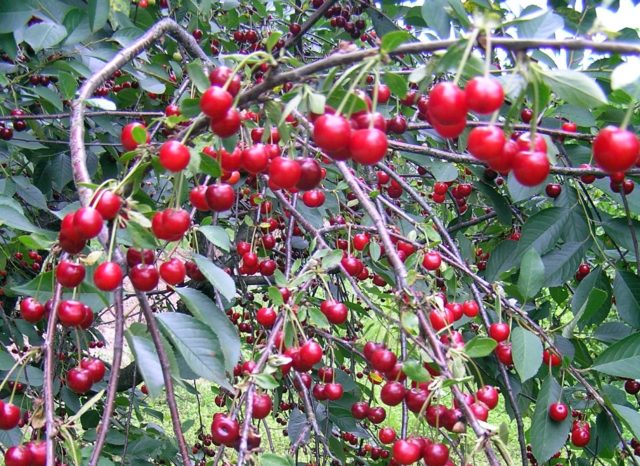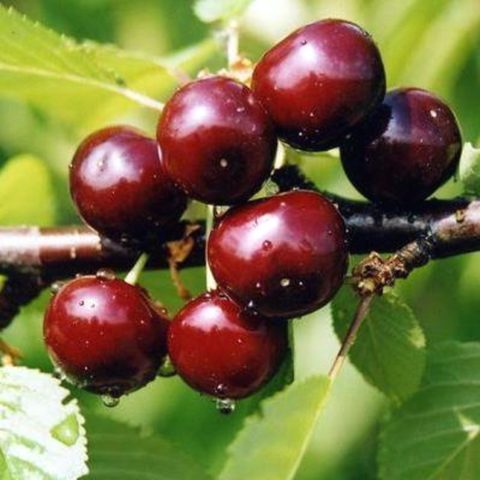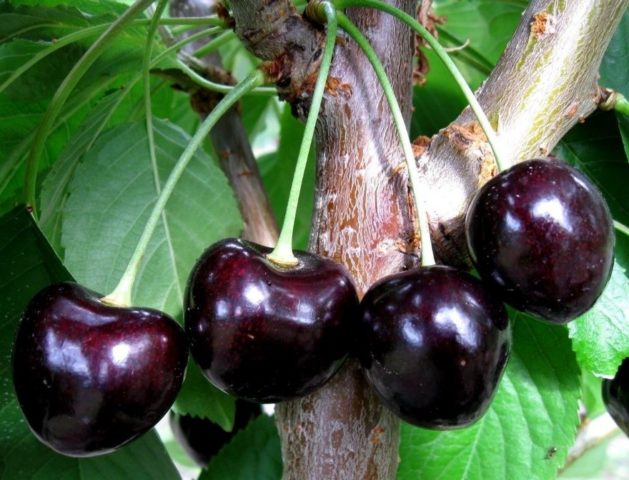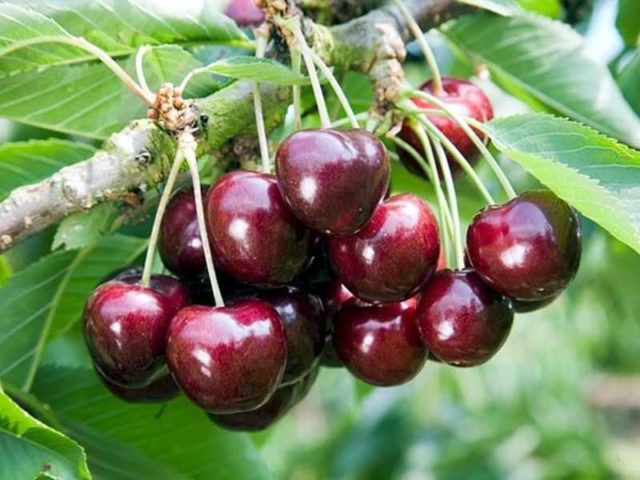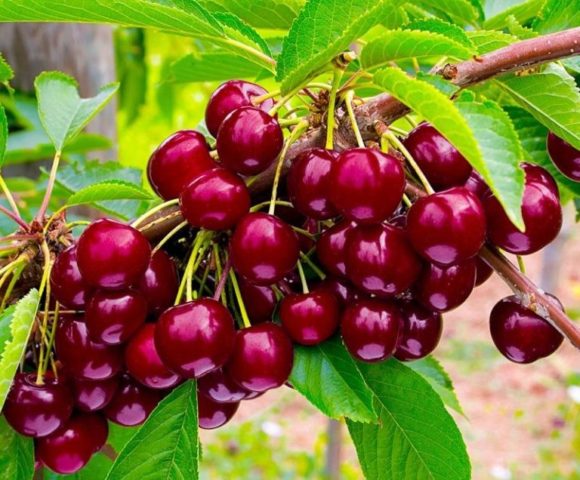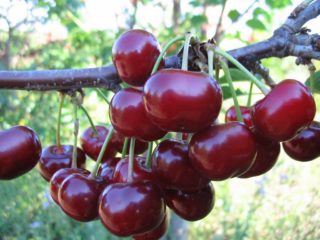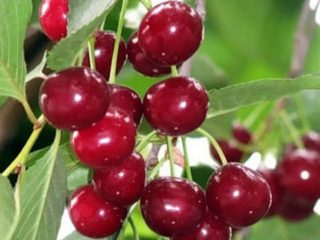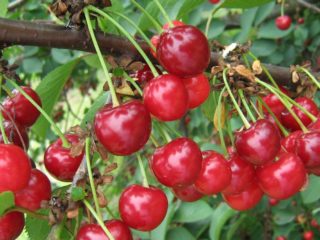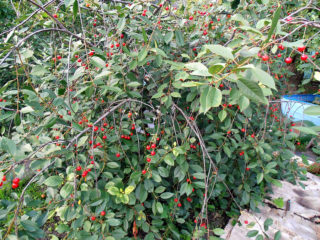Content
Cherry Duke Nursery is a stone fruit crop, which is a hybrid of cherry and sweet cherry with the best qualities taken from the parent plants. It belongs to the last generation hybrids, the author is A.I.Sychev.
Description of cherries Nurse
Duke's life form Nurse is a tree. Growth strength is medium. The bark of young shoots has a gray tint, which becomes darker with further growth.

Fruiting in sweet cherries is mixed, the main one occurs on bouquet branches
The leaves are large, dark green in color, elongated oval, more like cherry. Duke cherry x cherry Nursery is suitable for growing in central Russia.
Height and dimensions of cherries Nurse
Cherry cherries Nurse grows into a low compact tree up to 4 m in size. At a young age, the crown resembles a pyramid shape due to the fact that the skeletal branches are more tightly pressed to the trunk. With age, the crown acquires a more rounded shape.
Description of fruits
Cherry Nurse is distinguished by large fruits, each weighing 7-8 g. According to the photo and description of the Nurse cherry variety, the abdominal suture of the fruits is medium-sized, weakly expressed. The berries are dark red in color and have a round shape.
The pulp is dense, dark-colored, tender, with a delicate cherry aroma. The sweet taste of the fruit is marked as a reference. Tasting score - 4.8 points. When overripe, the color of the berries becomes rich-dark, and the taste is sweeter.
Pollinators for Duke Nurse
Duke Nurse is self-infertile. Nor is it pollinated by other cherries. The culture is planted in a separate group with cherries and cherries, while maintaining a distance of 3-4 m between plants. It is not recommended to include plums and apple trees in a close planting.
Cherry pollinating varieties:
- Lyubskaya;
- Bead;
- Youth;
- Bulatnikovskaya.
Cherry pollinating varieties:
- Iput;
- Jealous;
- Ovstuzhenka.
It is important that the pollinators of Nursery cherry coincide in flowering time, which occurs in the crop in May.
Main characteristics of Nursery cherries
Duke Nurse with a compact tree shape has a high yield. It has a well-developed root system and resistance to drought and frost. Cherry does not require complex care, it is immune to the main diseases of stone fruit crops.
Drought resistance, frost resistance
According to the studies carried out in 2005-2006. During the winter, when the air temperature in the experimental area dropped to the critical -40.5C °, the eight-year-old cherry-sweet cherry duke of the Kormilitsa variety survived in a satisfactory condition. Damage to wood was 3.5-4 points. The flower buds died completely.
The winter hardiness of the Duke Nursery is rated higher than that of a sweet cherry, but lower than that of a cherry. Flower buds of a crop can also be damaged in milder winters if there is a sharp, including short-term, temperature drop.
The drought resistance of the Nursery cherry is high.The culture in adulthood tolerates long periods of drought well and does not require special additional watering.
Yield
The ripening period of the cherry-cherry hybrid Nurse is medium, the berries turn red, depending on the growing region, in late June - early July. The first crop is harvested in the third year after planting. An adult tree bears about 13 kg of berries. Productivity largely depends on successful pollination. The fruits are suitable for fresh consumption, in compotes and preserves. Less suitable for freezing.
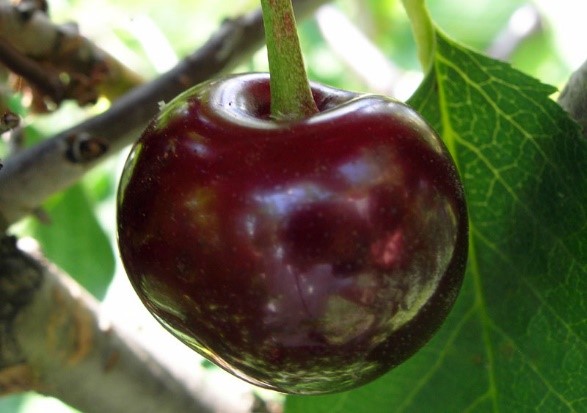
Cherry is large-fruited
The variety has average transportability characteristics. Fresh berries ripen well on the tree, they are collected and stored for a week.
Advantages and disadvantages
Duke Nurse has a higher frost resistance than sweet cherry, therefore it is suitable for growing in cold regions. Berries of excellent taste and large size. One of the advantages of cherries also include resistance to diseases and pests, minimal care.
The disadvantage or feature of the duke is its self-fertility and the need for pollinating trees.
Duke Landing Rules Nurse
For planting, choose one- or two-year seedlings with a closed root system. Simultaneously with planting a cherry-cherry hybrid or VCG Nurse, it is necessary to plant a pollinator with a simultaneous flowering period.
Recommended timing
A favorable time for planting cherries is early spring before the plant awakens, which is one of the first among stone fruits. The period from thawing snow to budding is usually short-lived, so it's important not to miss it. In the southern regions, it is possible to plant a Duke Nursery in the fall after the foliage has fallen. But with spring planting, the culture shows a higher survival rate.
Site selection and soil preparation
The place for planting cherries is chosen sunny, excluding areas with drafts and sharp gusts of cold winds. For successful cultivation, it is important that the groundwater does not lie close and that rainwater does not stagnate on the site. Level places on a hill are suitable for planting. The soil for the garden should be neutral in acidity. Lime is added to unsuitable soil from the previous season. Heavy soils are improved by thinning with sand.
How to plant correctly
The site for planting cherry-cherry seedlings is prepared in advance. The soil is dug up and loosened. A planting hole is dug 70 by 70 cm in size. The removed soil is mixed with organic fertilizers. In the future, a seedling is poured with this mixture, the soil is tamped and shed well.
After planting, the shoots are shortened in order to balance the volume of the crown with the size of the roots for their best development.
Care features
The peculiarity of caring for cherries Nurse includes correct shaping pruning, moderate feeding and shelter of the trunk for the winter. The soil under the tree is periodically loosened, kept clean of weeds. The rest of the culture is unpretentious and suitable for growing even by inexperienced gardeners.
Watering and feeding schedule
Cherries are additionally watered only after planting and at a young age. An adult tree does not need special watering and is even contraindicated. Waterlogging adversely affects the root system, leading to cracking of the bark.
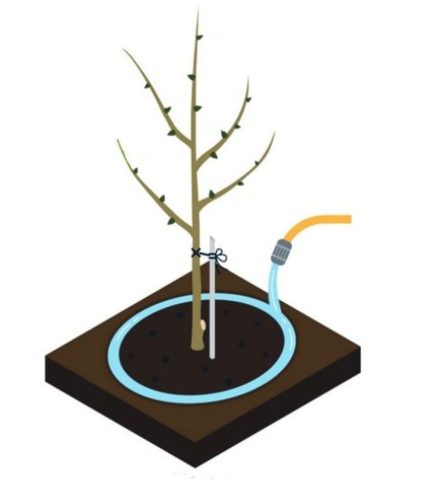
Duke watered over the projection of the crown
Top dressing for the duke must be carried out in small quantities, which is due to the peculiarity of the hybrid crown. Abundant fertilization provokes shoot growth, in which the wood does not have time to ripen and is severely damaged in winter. Fertilizers applied during planting are enough for several years.
Pruning
Cherries are recommended to be formed in the form of a low tree, which favorably affects fruiting and ease of harvesting.Formative pruning for the duke of the Kormilitsa variety is carried out annually up to 5 years of age. At the same time, it is important not to leave a tall bole, which is the most vulnerable near the tree in the cold season. For cherries, sparse-tiered pruning is suitable.
With this procedure, the growth of the branches is directed to the sides. To prevent the tree from growing in height, the upper central branch is cut off at the level of the last tier. The shoots below the skeletal ones are cut off completely.
During sanitary pruning, branches are removed that intertwine and compete with each other. A feature of cherries is that they do not form lateral growth.
Preparing for winter
In winter, the sweet cherry stem suffers from frost cracks. In order to protect the tree, the trunk and skeletal branches are whitewashed or wrapped with burlap, as well as other light-colored material. Young trees are completely covered, for this, the branches are pressed against the trunk, and a bag or other covering material is put on top.
Diseases and pests
Cherry has a high resistance to coccomycosis and moniliosis. According to the description and reviews of the Duke Kormilitsa variety, the culture is distinguished by strong immunity and is little exposed to other diseases characteristic of cherries and sweet cherries. Damage by pests was not noticed on the tree and fruits.
Conclusion
Cherry duke Nursery, like other cherries, has not yet been isolated into a separate culture. But they are considered promising for planting in the middle lane and getting sweeter and larger berries than cherries. The culture is easy to care for and has a high yield.
https://www.youtube.com/watch?time_continue=7&v=_Zc_IOiAq48
